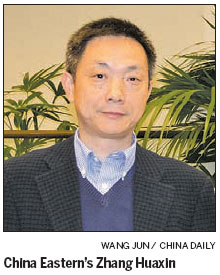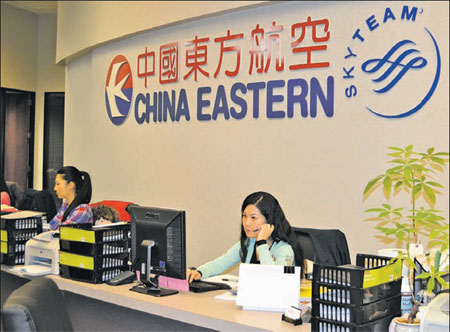Airline navigates tricky market
Updated: 2012-12-14 14:45
By Wang Jun in Los Angeles (China Daily)
|
|||||||||
|
Growing demand led China Eastern to boost call-handling capacity at its North America headquarters in Los Angeles. Wang Jun / China Daily |
Exploring the huge business potential of his new territory has been a top priority for Zhang Huaxin, who in the spring became North America general manager for China Eastern Airlines Corp, after 16 years in Japan with the State-run carrier.
China Eastern is China's third-biggest airline, and since arriving in Los Angeles, Zhang and Deputy General Manager Sean Shi have visited the US offices of rivals Air China and China Airlines.
They have also met with local partners such as Internet booking services, travel agencies and catering companies.
"Our LA flight now provides the best food among China Eastern's North America flights because our catering company hired a chef from Taiwan," said Shi, who helped the airline establish service to New York and open an office there in 2006.

Operations in Los Angeles were established back in 1991.
"It was a milestone for China Eastern. The flight between Los Angeles and Shanghai was our very first long-distance flight," Zhang said. For more than a decade, China Eastern was the only Chinese carrier flying the route.
Besides the two biggest US cities, China Eastern since 2003 has had direct service between Vancouver on Canada's Pacific coast and its home base of Shanghai.
Service between Honolulu and Shanghai was added this summer and will be increased to three flights a week from the current two by Dec 30. Next year, there will be five weekly Honolulu-Shanghai flights.
The carrier's next big move will be in San Francisco. Zhang said China Eastern plans to begin nonstop service between the northern California city and Shanghai in April. Additional flights on the Vancouver and New York routes are also expected.
Although the Los Angeles office officially became China Eastern's North American headquarters only in April, it has long played a de facto role as the center of intergovernmental relations, aircraft purchasing and code-sharing alliances with other major airlines.
To fully realize its potential as a regional center, the Los Angeles operation will have to integrate all marketing and sales functions under one roof, said Zhang, 51. In fact, his experience setting up regional headquarters for China Eastern prompted his relocation from Japan.
Zhang joined the airline in 1984 soon after graduating from Shanghai Railway University. Back then, China Eastern was still part of the Civil Aviation Administration of China. In 1996 he was sent to Japan to tackle that key market.
When Zhang arrived, China Eastern had five flights a week between Tokyo and Shanghai. By the time Zhang left Japan earlier this year, there were over 300 weekly flights between 16 Japanese airports and various cities in China. Japan became one of the airline's regional centers in 2009.
Recent tensions between China and Japan over control of the Diaoyu Islands have cost China Eastern some business this year in an important market. But Zhang doubts that the geopolitical dispute will do long-term harm to the two countries' economic relationship.
"Japanese business owners understand that they will suffer if they lose their Chinese business partners and the country as a market," he said.
"On a personal level, when the tension broke out a lot of Japanese bosses asked their Chinese employees working in Japan: 'Did you call home? They must be worried about you. Please call home.'"
With an easing of the territorial dispute, Zhang expects that China Eastern in 2013 will increase service between Shanghai and Tokyo to seven flights a week.
In the US, other priorities are dealing with the changing market dynamics, handling the volume of customer calls and adjusting operations to accommodate the 2014 delivery of new Boeing 777 jets.
Five years ago, about 70 percent of travelers between China and the United States were from the US, Shi said. Today, the figure is 65 percent from China, due to relaxation of US visa policies for Chinese, among other factors.
With a higher percentage of travelers coming from China, the airline's US operation has begun targeting the high end of the US clientele, such as customers deemed VIPs.
"The lack of a North America call center is a bottleneck for us," Shi said, adding that he and Zhang have even received calls on their cell phones to book flights or check schedules during busy times.
The temporary solution is a hotline to China Eastern's call center in Shanghai. Although it's a short-term fix, it's much cheaper than opening and operating a dedicated call center on US soil.
As they wait to see whether the hotline - its current capacity is 23 simultaneous calls - can handle increasing demand, the airline executives are using other customer-service channels. In 2010, China Eastern introduced a smartphone app that lets users book flights and get schedule updates.
Next year, China Eastern's North America website, currently under reconstruction, will provide more complete, current information as well.
"More importantly, we'll start to use client representatives, who are always in touch with their clients and can anticipate customer needs and questions."
When the airline takes delivery of its first Boeing 777 in less than two years, it will be deployed on New York routes. The fuel-efficient aircraft is expected to help China Eastern contain costs, and New York is its most expensive operation.
By the end of 2014, the Los Angeles-Shanghai route will begin flying 777 jets, Zhang said.
wangjun@chinadailyusa.com

 Relief reaches isolated village
Relief reaches isolated village
 Rainfall poses new threats to quake-hit region
Rainfall poses new threats to quake-hit region
 Funerals begin for Boston bombing victims
Funerals begin for Boston bombing victims
 Quake takeaway from China's Air Force
Quake takeaway from China's Air Force
 Obama celebrates young inventors at science fair
Obama celebrates young inventors at science fair
 Earth Day marked around the world
Earth Day marked around the world
 Volunteer team helping students find sense of normalcy
Volunteer team helping students find sense of normalcy
 Ethnic groups quick to join rescue efforts
Ethnic groups quick to join rescue efforts
Most Viewed
Editor's Picks

|

|

|

|

|

|
Today's Top News
Health new priority for quake zone
Xi meets US top military officer
Japan's boats driven out of Diaoyu
China mulls online shopping legislation
Bird flu death toll rises to 22
Putin appoints new ambassador to China
Japanese ships blocked from Diaoyu Islands
Inspired by Guan, more Chinese pick up golf
US Weekly

|

|








